For a long time I have advocated the use of camouflaged smocks. Surprisingly it is hard to get the idea that camouflage should be worn over the armour into some heads!
In a previous blog post I discussed the idea of camouflaged aprons or tabards. While I like the simplicity of this approach I feel it still has a way to go. Some of the illustrated examples are overly long and have too rectangular and regular a shape. Most obviously they do little to camouflage the distinctive arm and shoulder region.
Recently I was having a conversation and recalled this:
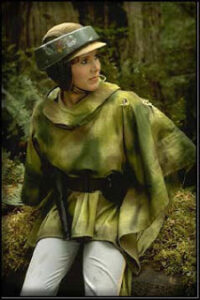
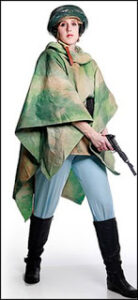
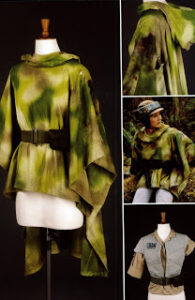

Several of the rebel characters on Endor wear these ponchos. Since it is not raining they seem to be primarily for camouflage. Leia’s, at least, seems to be rigged so that it is relatively short at the front, providing freedom of movement.
In his book mentioned in the previous post Langdon-Davies notes that the sniper suit (and personal camouflage in general) is:
“to destroy your human shape, as well as your human features. It is therefore cut as unlike a Savile Row tailor’s suit as possible”
and that “For many purposes the sniper’s suit may be thought too clumsy and readers are advised to experiment by making hoods of a larger size reaching to the waist. These can easily be taken off when the moment comes to run, and they do not in any case impede the movements of the legs”
A poncho is very good at concealing the shape of the human body. In previous posts I have discussed ponchos and shelter cloths as rainwear and I have discussed ponchos, blankets and cloaks as cold weather wear. Suppose we merge the idea of the camouflage apron and poncho to create a garment intended for camouflage rather than warmth or rain protection. Here, a similar idea is called a “bush rag”.
What I suggest is something roughly hexagonal in shape, folded across two opposite points. Its width would be about an arm span as measured between the elbows. This would be half an wearer’s height by Vitruvian proportions. At the front and back it would be about mid-thigh length to provide freedom of movement. Using the Roman tunica as an illustration, the camo-poncho would not be as long and would taper towards the lower edges. The sides would not be seamed. One of my reasons for mentioning the tunica is that like this garment the poncho would most likely be clinched, the equipment belt or webbing securing the flaps. Tapes or cords can be added for when a belt is not worn. The sides below the belt would not be joined for better freedom of movement when crawling or climbing.
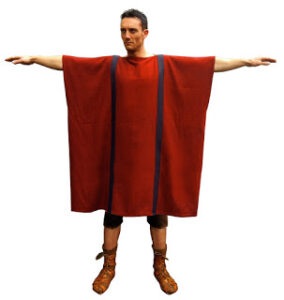
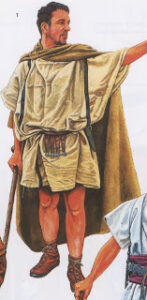
Being a very simple garment it is more practical to make the camo-poncho double-sided. One side could have a verdant pattern and the other a more brown and tan pattern suited to semi-arid, autumnal and many urban environments. Another version would have a desert pattern on one side and a semi-arid pattern on the other. Another variant would have pure white on one side and a pattern for broken snow on the other.
The camo-poncho (smocklet, ponchoet?) would use a contrasting macro-pattern that breaks up its shape. There is little point trying this concept with some of the multi-coloured patterns currently in vogue that blob-out into a single monocolour. In the pattern below individual polygons should be about three or four inches across. Mesh in useful patterns such as CCE can be found.
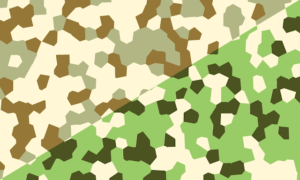
The double-sided camo-poncho could be created by simply sewing two differently patterned sheets together. A hexagonoid shape can easily be made from rectangles and rectangles cut diagonally. The hem would be made several inches from the edge and the cloth outside allowed to fray. It might even be cut into tassels like a buckskin shirt. The frayed edges and tassels further break up the recognizable shape and assist in the garment drying when wet.
Since the camo-poncho is unlikely to see a parade ground we can add some patches of cloth, hessian and netting to make it three-dimensional, as was discussed for headgear. The poncho could work in conjunction with other ideas such as the soldier’s mantle.
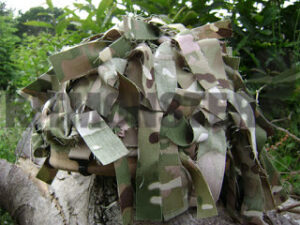
Just to be clear. The camo-poncho is not intended to replace the rain poncho or poncho-liner. The soldier would also carry these items and use them when needed. They are vital components of his lightweight sleeping system. The camo-poncho is not intended to act as a shelter or provide warmth. One of its advantages is that air easily circulates under it, which will be welcome in hot climates. The camo-poncho is designed to provide the wearer with concealment. Warm clothing, including a poncho-liner, can be worn under it if the climate warrants. The camo-poncho can be worn over a waterproof jacket or rain poncho, providing camouflage and snag-protection and also muffling the noise of these materials.
Hunters, wildlife photographers and the like should feel free to try this concept out. It requires minimal sewing skills and is likely to be far superior to more expensive, tailored options.